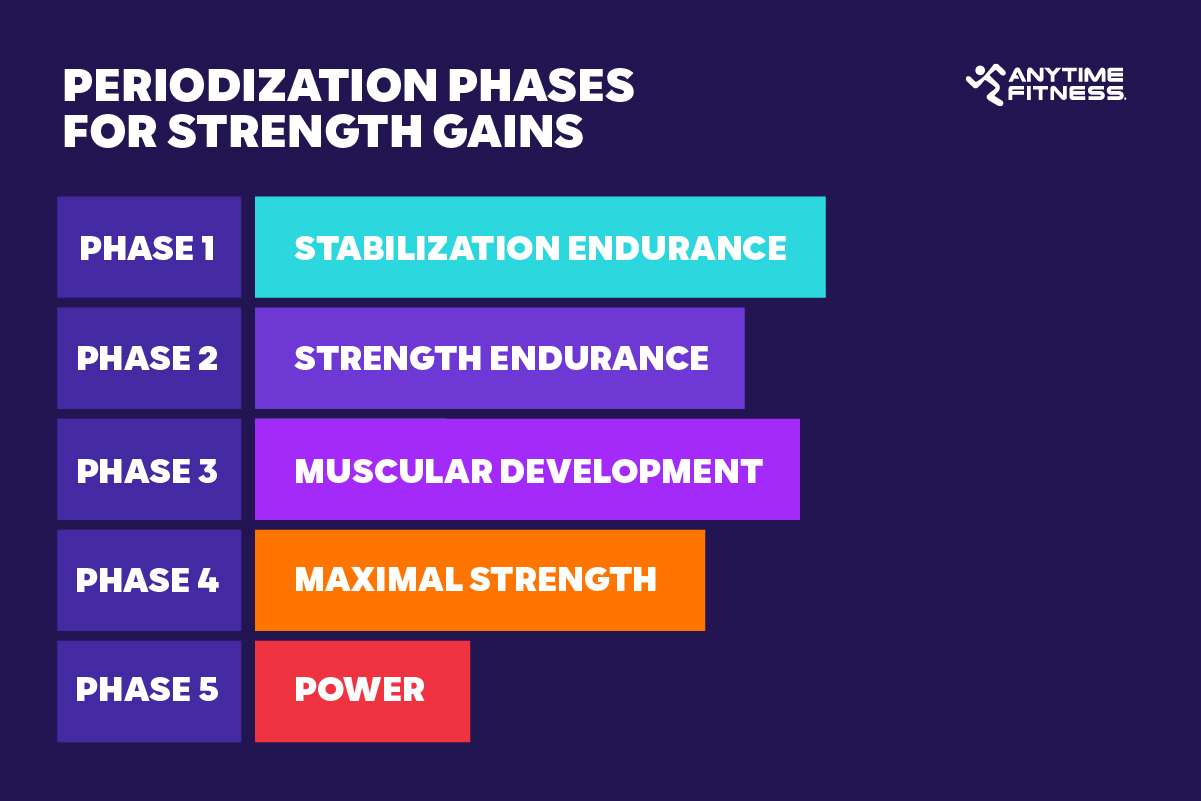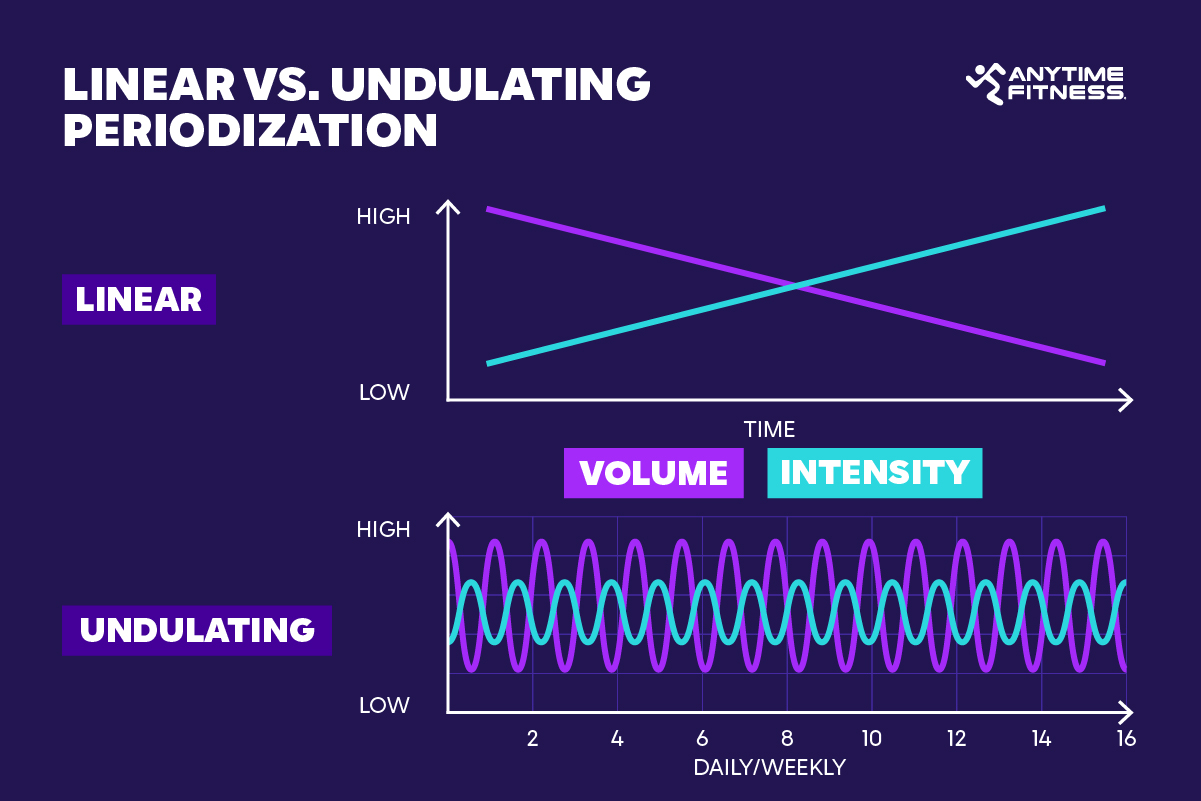When it comes to the daily practices of high-level athletes, quality sleep, smart training, and dialed-in nutrition are the secret sauce to peak performance. What many don’t see, however, is that the pros don’t go full throttle every day — there’s strategic design behind their methods, like cycling through phases of training in an effort to balance intensity, focus, and volume over time. Following a periodized approach helps the body gradually build strength and endurance, setting the foundation for safe (and sustainable!) progress.
Just like the weather changes throughout the year, your strength training should, too.
In strength training, consistency is key to achieving fitness goals — but staying on cruise control with little to no variety can stall your results and leave your gains to chance. Our bodies become less responsive to the same old stimuli. Instead of riding the highs and lows of intensity, we work out just hard enough to feel the burn but don’t go far enough for true progress.
Enter: periodization training. This smart approach guides the body through predetermined cycles, each one assigned its own focus and intensity level. Moving through a series of specific phases keeps the body guessing as it forces continuous adaptation and growth. Let’s talk about how periodization can help you achieve your long-term fitness goals faster. We’ll cover:
- What is periodization?
- The benefits of periodization
- Types of periodization
- How to create a periodized workout plan
What is periodization in weight training?
Periodization breaks your training into phases with different focuses — building muscle, pushing limits, and recovering. In the realm of strength training, periodization is characterized by changing up variables like rep ranges, tempo, sets, and intensity in a series of well-planned phases to target specific goals.
As your intensity notches up, then your volume should scale down — and vice versa. This strategy helps fine-tune your workouts for the milestones you’re working toward.
The benefits of strength training periodization
Whether you’re newer to strength training or have been lifting for years, understanding strength training periodization can take your fitness to the next level.
In pursuit of their goals, many training devotees unknowingly settle into the middle ground, hovering at moderate training intensities that neither allow the body to fully recover or break through to new heights.
Strength training periodization provides a structured plan to help your body adapt to new challenges without overloading it. Among its advantages, periodization has the power to:
- Reduce your risk of injury. Planned recovery and lower training intensities reduce the risk of injury. Instead of constantly pushing the body to its limits, periodization gives the muscles, joints, and connective tissues time to recover and adapt. This promotes longevity in training as it allows the body to rebuild stronger and more resilient after periods of stress.
- Pump up your progress. Keeping workouts challenging and varied helps the body push past plateaus — whether it’s upping the ante on intensity, switching up exercises, or varying the total number of reps. This keeps the muscles guessing, prevents stagnation, and drives progress toward your weight training goals.
- Help your muscles adapt. Targeting different aspects of strength, power, and endurance over time improves muscle adaptation. Alternating between phases of training intensities, volume, and recovery trains your muscles to adapt to different stressors, promoting faster growth and greater strength gains.
Periodized phases: The long, medium, and short of it
The periodization strength training model from NASM consists of three levels — stabilization, strength, and power — broken down into five distinct phases, each designed to help build up a strong foundation and progress toward peak physical performance:
- Phase 1: Stabilization endurance
- Phase 2: Strength endurance
- Phase 3: Muscular development
- Phase 4: Maximal strength
- Phase 5: Power

Phase 1: Stabilization endurance training
Stabilization endurance training builds core stability, endurance, and proper posture during movements. Advanced athletes and advanced strength trainers use stabilization for active recovery, otherwise known as a deload phase. With light to moderate weights and higher rep ranges, the focus is all about mastering movement quality. This phase improves joint mobility, core strength, and overall endurance.
Phase 2: Strength endurance training
This phase brings in superset techniques, where you pair a strength-focused move with an endurance exercise right after with little to no rest in between. (Think: a bench press followed by a push-up, or a barbell squat followed by a single-leg squat.) The result is a one-two punch that builds muscle and boosts stamina.
Phase 3: Muscular development training
Also referred to as hypertrophy, the muscular development training phase is all about incorporating higher volume workouts with moderate weights and more reps. It’s intended to prime the body for more intense training phases later on by increasing volume and intensity — that means more sets, lower reps, and more exercises per body part.
Phase 4: Maximal strength training
Characterized by pushing your body’s limits, this phase zeroes in on low rep range, high intensity sets designed to help you increase your one-rep max. Maximal strength training challenges your muscles to handle maximum loads.

Phase 5: Power training
Power training is where strength and speed intersect. You’re exerting maximum effort in the shortest amount of time, combining heavy weights with high-powered movements. In periodization, power training is typically seen as the most technical phase because it translates the muscle and strength gains from previous phases into generating force rapidly.
Note: It’s common for most people to cycle through phases 1 and 2 during their training schedule. Phases 3, 4, and 5 are optional based on your personal goals and abilities. An Anytime Fitness Coach or other fitness professional can help you determine which phases should be part of your specific training cycle.
Types of periodization: Linear vs. undulation
To optimize performance, there are two main types of strength training periodization: linear and undulating. Each offers a unique approach to structuring workouts — the key differences lie in how the intensity and volume levels are adjusted over time.
Linear periodization
With linear periodization, steady and predictable progression wins the race. This method ramps up heavier weights with fewer reps as you cycle through each periodized phase. Linear periodization typically starts out with higher reps and lighter weights to build on endurance levels before moving toward max strength and power.
Here’s an example for someone looking to increase overall muscle strength as well as add muscular size:
- Week 1–4: Stabilization endurance training
- Week 5–8: Strength endurance training
- Week 9–12: Muscular development (hypertrophy) training
Linear periodization is ideal for those newer to strength training, recovering from injury, or for those who need an extended focus on building stability.
Undulating periodization
Undulating periodization switches up the volume, intensity, and exercises within a weekly program, so you’re focusing on different goals with each workout. Instead of progressing in a straight line, undulating periodization brings in multiple phases of training spread across different workouts in your weekly program. Changing the focus of your workouts throughout your week can help you avoid boredom in the gym and add variety to your routine in a structured way.
For example:
- Monday: Stability training
- Wednesday: Strength training
- Friday: Power training
The variation with this approach allows for heavier and lighter training days, giving your muscles time to heal without hindering progress.

How to make periodization work for you
There is, of course, no one size fits all for a periodization plan — it’s a constantly evolving puzzle as you try to keep your (very specific!) goals, workout levels, and recovery needs in check. Here are a few tips to keep in mind when working with a Coach to determine a periodized plan that works for you.
1. Find balance in periodization training.
We want it all, right? Bigger muscles, greater gains, and peak performance. Balancing these goals means you need to be strategic and planful in an effort to avoid overtraining and neglecting major focus areas.
2. Prepare to pivot.
Life doesn’t always go as expected — work, personal matters, stress, or sickness can throw things off. Your periodized training plan needs to have an element of flexibility factored in to accommodate the occasional surprise. Just like pro athletes and their trainers make room for real-time changes, your expert Anytime Fitness Coach can help you fine-tune the right progression for your plan.
3. Plan ahead for strength training periodization.
A periodized strength training program hits on variables like strength, endurance, and hypertrophy — but working on some of these simultaneously could hinder your progress. It’s important to understand when it’s time to focus on each and how long you should prioritize one variable over another.
For instance, if you try to build muscle size and max out strength all at once, you’ll likely hit a wall. Focus on hypertrophy for 6–8 weeks, then shift to heavier weights and lower reps for strength gains. This way, each goal gets its time to shine, and you’ll see better results without burning out.
Proper planning is a non-negotiable. Talk to your Anytime Fitness Coaches, who have the know-how and expertise to tailor your plan, guide you through each phase, and keep things progressing.
A final word on periodization training
To fully embrace strength training periodization, it’s all about incrementally introducing structure into your routine. Start things off with stabilization training. Aim to conquer one phase at a time, whether you’re building endurance or looking for power gains, and give your body the space it needs to adapt. Ease into it and let each phase build on the last.
Last, but certainly not least, trust the process — remember that periodization drives you forward, even when the results feel slow to show.
Reminder: The Evolt 360 body composition scanner, available in many Anytime Fitness gyms, offers more than 40 unique measurements — from body fat percentage to muscle mass — to help you track your progress.
More strength training tips
Ready to try periodization training? Team up with an Anytime Fitness Coach for one-on-one training to get a customized periodization plan aligned to your personal goals.



